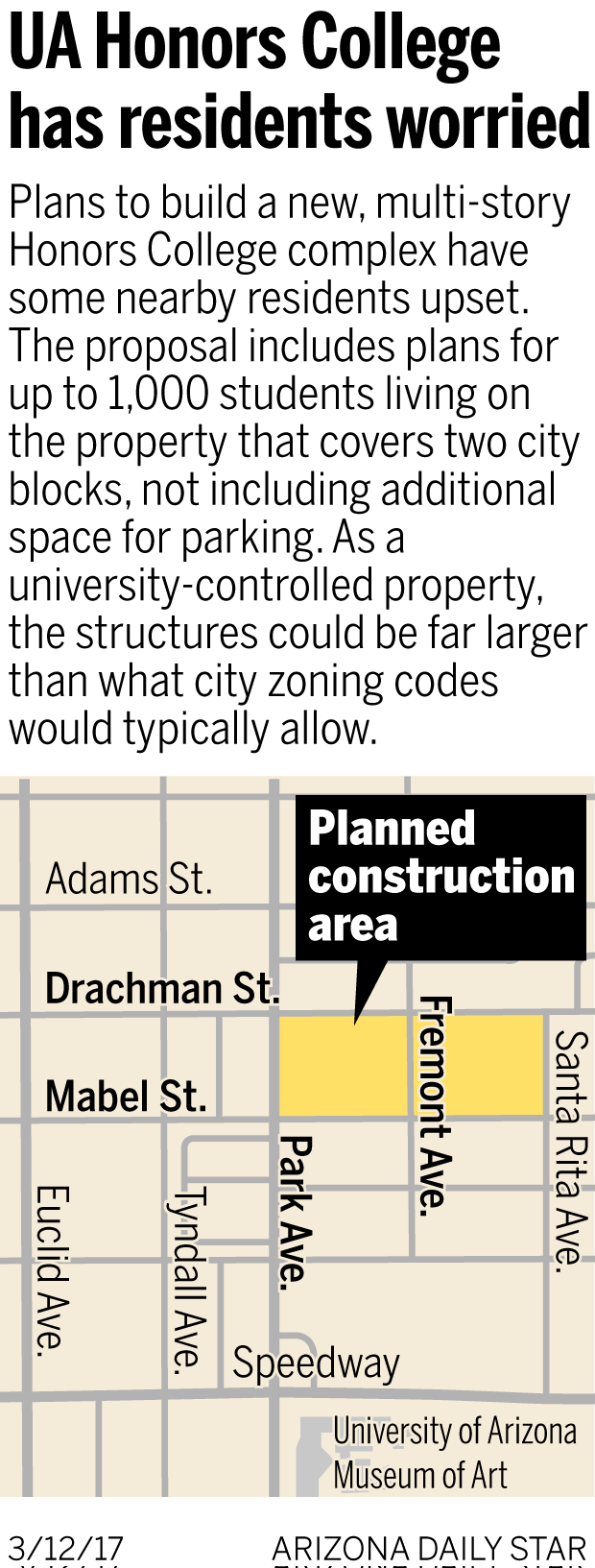Residents of a neighborhood just north of the University of Arizona main campus are upset about plans to build a multistory 1,000-bed dorm and classroom complex for students attending the UA Honors College.
Many residents say they are concerned they haven’t been consulted about the proposal and that the property, owned partially by the UA and the privately owned American Campus Communities, is outside the official campus boundaries.
ACC, based near Austin, Texas, is one of the nation’s largest developers of student housing communities in the country. It owns Entrada Real student apartments with 98 units and more than 350 beds near the UA, according to its website.
The proposal includes a dorm that would span an entire city block between East Drachman and Mabel streets and North Fremont and Santa Rita avenues, just north of East Speedway, and could be four to six stories tall. Other plans include classrooms, office space, a recreation center and a four-story parking garage to be built on the adjacent block between North Park and Fremont avenues.
The university is also considering demolishing several buildings along Park Avenue between Drachman and Adams streets, and putting in surface lots to offer additional parking.
The neighborhood now consists of homes, apartments catering to students, university parking lots and vacant land.
Many neighbors say they feel powerless, noting that as part of the state, the university does not have to abide by city zoning codes, including when it comes to building height, density and parking requirements.
For example, the height limitation for the surrounding neighborhood is 25 feet, or roughly two stories tall.
University officials have confirmed they are in the planning stages of the project and have begun preliminary discussions with some neighborhood residents as well as with ACC about a potential partnership in developing the property.
“We’ve been looking for a bigger, better home for honors for at least two years,” said Robert Smith, UA vice president for university planning, design and operations.
“The goal is to move our Honors College program to the next level by having all of the faculty, classrooms, beds and the students and everything together. Being spread out is not efficient.”
Currently, many UA students who are part of the Honors College live in residence halls close to Euclid Avenue and Sixth Street. The UA says there are more than 4,000 students enrolled in the Honors College.
UA officials said they’ve already made some changes to be better neighbors, including decreasing the number of floors of the dorm facing the neighborhood from six to four, and placing the entrance to the college on the south side to reduce noise and traffic generated by students.
“One of the things that is important is to lower the impact to the neighborhoods,” said Tannya Gaxiola, an assistant vice president for community relations at the UA. “Being really good neighbors is really important as we were talking through what the project would look like.”
Diana Lett, the neighborhood preservation committee chair for the Feldman’s Neighborhood Association, said she feels the university’s plans so far demonstrate a lack of transparency and little respect for the desires of the surrounding communities.
“Rather than compromise with the public and build a project we could live with, ACC and our public university chose to do an end-run around the city of Tucson — rezoning that would be required if the parcel remained privately owned,” Lett said.
The university is supposed to build within planning boundaries, she notes, as part of its adopted Comprehensive Campus Plan and the proposed Honors College is outside the UA’s northern planning boundaries.
Several residents who spoke to the Arizona Daily Star about the project echoed similar concerns.
The campus plan is a formal planning document outlining the university’s physical development of its land and construction projects, and mapping out its long-range plans to meet the educational needs of a growing student body.
Smith said he expects the new master plan will be released next year, and won’t comment on whether the boundaries — set in 2009 — will change.
While the 2009 plan showed the boundary to be just south of this proposed project, it included a reference to this area and stated that a “university partnership housing project on UA property located north of the planning boundary” is possible.
Smith said ACC has always had plans to develop the properties it owns in the neighborhood into some type of student housing.
Running his hand over a map, Smith motioned to the run-down properties the UA owns along Park Avenue between Mabel and Adams streets, mostly aging apartments.
“I personally think this is pretty unattractive here, but I don’t presume to know what the neighbors think,” Smith said.
City Councilman Steve Kozachik, a UA employee, said his hands are tied in terms of the city stepping in to help ease the resident’s concerns.
He said the university’s plans for a new dorm may be following proper legal channels, but are hurting its reputation with surrounding neighborhoods.
“Sometimes there’s what’s legal and expeditious, and sometimes there’s what you can get away with but it destroys your credibility. In this case, the UA is doing both,” Kozachik said. “More importantly is the UA losing trust. Once that’s gone, you’ve lost everything going forward.”
Kozachik has requested a joint meeting to include UA representatives, ACC officials, the city attorney and surrounding neighborhoods, but no date has been set.





